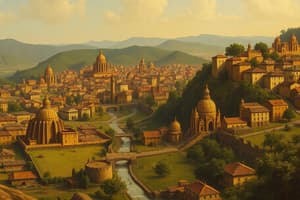Podcast
Questions and Answers
Where was the Indus Valley Civilization primarily located?
Where was the Indus Valley Civilization primarily located?
- Northeastern Asia
- Northwestern South Asia (correct)
- Southern Africa
- Central Europe
What is one of the key features that the Indus Valley Civilization is recognized for?
What is one of the key features that the Indus Valley Civilization is recognized for?
- Urban planning (correct)
- Pyramid construction
- Feudal system
- Military conquests
What evidence suggests that the Indus Valley Civilization was a prosperous trading nation?
What evidence suggests that the Indus Valley Civilization was a prosperous trading nation?
- Nomadic lifestyle of its people
- Advanced military weaponry
- Lack of agricultural development
- Evidence of trade routes to Mesopotamia, Egypt, and India (correct)
What characterized the economy of the Indus Valley Civilization?
What characterized the economy of the Indus Valley Civilization?
What was a notable feature of the cities in the Indus Valley Civilization?
What was a notable feature of the cities in the Indus Valley Civilization?
What aspect of the Indus Valley Civilization had a distinct identity showcased through art, jewelry, seals, and other artifacts?
What aspect of the Indus Valley Civilization had a distinct identity showcased through art, jewelry, seals, and other artifacts?
What remains a challenge to scholars despite evidence of around 45 letters being used in the civilization?
What remains a challenge to scholars despite evidence of around 45 letters being used in the civilization?
What is a matter of debate regarding the decline of the Indus Valley Civilization?
What is a matter of debate regarding the decline of the Indus Valley Civilization?
What continues to influence the modern world despite the relatively brief existence of the Indus Valley Civilization?
What continues to influence the modern world despite the relatively brief existence of the Indus Valley Civilization?
What valuable insight does understanding the Indus Valley Civilization provide?
What valuable insight does understanding the Indus Valley Civilization provide?
Study Notes
Exploring the Indus Valley Civilization: A Primer on Ancient History
In the vast tapestry of ancient history, one of the most fascinating and intriguing civilizations is the Indus Valley Civilization. Spanning from approximately 3300 to 1300 BCE, this ancient society is recognized for its impressive urban planning, advancements in trade, and cultural richness.
Background and Location
The Indus Valley Civilization was primarily located in the northwestern region of South Asia, where present-day Pakistan and northwestern India meet. The Indus River and its tributaries played a crucial role in shaping the landscape. The civilization thrived in cities such as Mohenjo-daro and Harappa, which are considered among the world's earliest urban societies.
Urban Planning and Infrastructure
The Indus Valley Civilization is renowned for its sophisticated urban planning and infrastructure. The cities were designed with well-planned streets, sophisticated drainage systems, and public baths. The architecture was advanced for its time, with multi-story buildings, brick structures, and intricate sewage systems.
Trade and Economy
The Indus Valley Civilization was a prosperous trading nation, with evidence of trade routes extending to Mesopotamia, Egypt, and India. The civilization was self-sufficient, producing a wide array of goods, including textiles, pottery, and metalware. A system of weights and measures was in place, ensuring that trade was fair and transparent.
Cultural and Religious Life
The Indus Valley Civilization had a distinct cultural identity, showcased through art, jewelry, seals, and other artifacts. The civilization had a complex social structure, with evidence of strata, including merchants, artisans, priests, and laborers. Seal impressions showcase the use of a script with around 45 letters, but its decipherment remains a challenge to scholars.
Social Structure
The Indus Valley Civilization had a complex social structure, with evidence of multiple strata in society. The civilization had a hierarchical structure, with merchants, artisans, priests, and laborers. The urban centers were densely populated, with estimates suggesting populations of up to 50,000 people in cities like Mohenjo-daro.
Decline and Legacy
The Indus Valley Civilization came to an end around 1300 BCE, with the reasons for its decline still a matter of debate. Some theories suggest environmental factors, such as climate change, while others point to external invasions. Despite its relatively brief existence (approx. 2000 years), the Indus Valley Civilization has left a lasting legacy. Its contributions to urban planning, agriculture, trade, and social organization continue to influence the modern world.
The Indus Valley Civilization remains a fascinating and intriguing subject, with new discoveries and interpretations shedding light on one of the earliest and most influential civilizations in human history. Understanding the Indus Valley Civilization provides valuable insight into the development of urban societies, the rise of trade networks, and the complexities of ancient social structures.
Studying That Suits You
Use AI to generate personalized quizzes and flashcards to suit your learning preferences.
Description
Test your knowledge about the Indus Valley Civilization with this informative quiz covering its background, urban planning, trade, culture, social structure, decline, and lasting legacy. Explore the rich history and influence of this ancient society.




